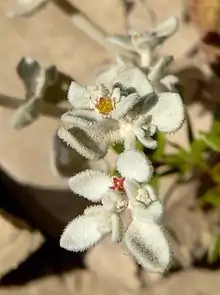Tidestromia suffruticosa
Tidestromia suffruticosa, the shrubby honeysweet,[2] is a perennial plant in the family Amaranthaceae of the southwestern United States and northeastern Mexican deserts. It has one of the highest rates of photosynthesis ever recorded.[3] It flowers from April to December.[3] It can survive very high temperatures, growing successfully in extreme environments such as Death Valley,[4] and the genetic basis for this is being studied with a view to making hardier crop plants to better cope with climate change.[5]
| Tidestromia suffruticosa | |
|---|---|
 | |
| Flowers | |
| Scientific classification | |
| Kingdom: | Plantae |
| Clade: | Tracheophytes |
| Clade: | Angiosperms |
| Clade: | Eudicots |
| Order: | Caryophyllales |
| Family: | Amaranthaceae |
| Genus: | Tidestromia |
| Species: | T. suffruticosa |
| Binomial name | |
| Tidestromia suffruticosa | |
| Synonyms[1] | |
| |
Subtaxa
The following varieties are accepted:[1]
- Tidestromia suffruticosa var. oblongifolia (S.Watson) Sánch.Pino & Flores Olv.
- Tidestromia suffruticosa var. suffruticosa
References
- "Tidestromia suffruticosa (Torr.) Standl". Plants of the World Online. Board of Trustees of the Royal Botanic Gardens, Kew. Retrieved 21 April 2021.
- USDA, NRCS (n.d.). "Tidestromia suffruticosa". The PLANTS Database (plants.usda.gov). Greensboro, North Carolina: National Plant Data Team. Retrieved 10 December 2015.
- MacKay P (2013). "Green and Brown Flowers". Mojave desert wildflowers: a field guide to wildflowers, trees, and shrubs of the Mojave Desert, including the Mojave National Preserve, Death Valley National Park, and Joshua Tree National Park. p. 260. ISBN 978-0-7627-9388-4.
{{cite book}}:|work=ignored (help) - Björkman O, Pearcy RW, Harrison AT, Mooney H (February 1972). "Photosynthetic adaptation to high temperatures: a field study in death valley, california". Science. New York, N.Y. 175 (4023): 786–789. Bibcode:1972Sci...175..786B. doi:10.1126/science.175.4023.786. PMID 17836139. S2CID 20986880.
- Klein A (3 August 2023). "Flower that thrives in Death Valley may hold secret to heat adaptation". New Scientist.
This article is issued from Wikipedia. The text is licensed under Creative Commons - Attribution - Sharealike. Additional terms may apply for the media files.